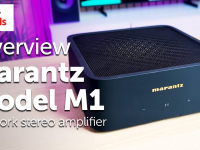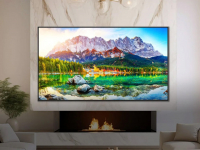
AudioQuest’s DragonFly USB Digital-to-Analogue Converter (DAC) shone a new light on the US-based manufacturer, previously best known for their audio cables. Their first time effort in the category soaked up rave reviews across the globe, paving the way for a legion of imitators to follow suit.
With the original having seen released in 2012, an upgraded ‘1.2’ version followed in 2014, taking just as many plaudits as its predecessor. Now, in 2016 AudioQuest have released not one but two replacements: DragonFly Black and DragonFly Red. Today we’ll be specifically focusing on the Red, which is AudioQuest’s top model of the two.
So, the Red is a USB dongle-style digital-to-analogue converter, perfect for use on the go (with iOS and Android devices), at home (via laptops and Mac/PC’s) and can be used either with headphones or directly into a hi-fi or home cinema system for those who only have computer audio in mind for their system. When testing it we used it primarily with headphones, both from an Android phone and a laptop.
Specification lists are never particularly lengthy on this type of product, but what is there is all very pleasing to see. The Red contains an ESS Sabre DAC chip, the 9016, which in this implementation is capable of decoding sample rates up to 24-bit/96kHz. Output is a healthy 2.1 volts, making it the same as a full line-level device and providing plenty of grunt to drive even the most difficult of headphones, too. AudioQuest have also utilised a 64-bit, bit-perfect digital volume control. This helps to ensure that minimal information is across the volume range whilst keeping the signal-to-noise ratio down to a minimum. Finally, the Red uses AudioQuest’s own Asynchronous Streamlength USB coding, meaning the DAC is solely responsible for the transfer of the incoming signal rather than the PC/phone/tablet itself.
 AudioQuest have built-in support for Windows 7/8.1/10 and Apple OS X. Those wanting to use it with an Apple mobile device will need to purchase an Apple Camera Adapter, whilst those that opt for Android devices will need a made for Android/OTG adapter. No additional driver installation was necessary, with the AudioQuest working perfectly with no extra downloads. With all that said, it’s on to the listening!
AudioQuest have built-in support for Windows 7/8.1/10 and Apple OS X. Those wanting to use it with an Apple mobile device will need to purchase an Apple Camera Adapter, whilst those that opt for Android devices will need a made for Android/OTG adapter. No additional driver installation was necessary, with the AudioQuest working perfectly with no extra downloads. With all that said, it’s on to the listening!
Given the range of file resolutions the Red is capable of playing back, I queued up a playlist that would allow me to really see what it was able to do. Music ranged from the 24-bit FLAC version of Radiohead’s latest masterpiece, A Moon Shaped Pool, down to internet radio stations that were not really going to win any awards for basic sound quality. The Red showed itself to be a brilliant, confident performer throughout all of my listening session, even though I’d set it the Herculean task of driving my Sennheiser HD800 headphones from start to finish. Considered to be one of the finest over-ear designs ever released to market, the HD800 is renowned for its hyper-revealing performance, offering a very much warts-and-all take on all it plays. It’s also one of the trickiest headphones to match up to corresponding equipment, and when matched poorly can underwhelm.
Through the DragonFly Red, they sounded absolutely fantastic. The hefty power output alluded to earlier drove them to ear-splitting levels with ease, maintaining their fantastic soundstaging capability and effortless detail retrieval all the while. Getting stuck into the Radiohead album, something I’ve done many, many times since its release a month ago, proved that AudioQuest’s success last time around was no fluke. On Ful Stop, the whole band explodes midway through the track, after a slow and steady build dominated by a warbling bass synth and Thom Yorke’s rambling lyric. Yorke’s vocals are often a bone of contention amongst music fans for being almost unintelligible, so drenched are they in effects. The Red helped to lift the veil off, showing a real clarity to Yorke’s voice where others have failed. When the band do finally pile in, the foot-tapping kicked off immediately, with the DragonFly proving itself to be amongst the most rhythmically adept devices I’ve heard for a while. The track was cohesive, with all performers locked tightly in their groove, but the sense of space and air around instruments made everything feel huge and brilliantly worked. Again, that all this was achieved from a relatively modest priced DAC into high-end diva-like cans marked the Red down as exceptional.
Switching to the aforementioned internet radio stations, namely Groove Salad from Soma FM, showed how the DragonFly could sprinkle its magic on relatively low-res recordings. This ambient/downtempo station was given a lease of life not always afforded to radio. Highs were open and clear, bass was deep and rich, and it really felt like I was listening to a much higher quality broadcast than I was. Again, the sense of space around instruments and the Red’s way with rhythm made the experience a very enjoyable one, improving upon my laptop output immeasurably.
Many hours of listening later, the DragonFly had continued to impress. The bottom line was this: if I were to use this DAC at home in my main system I would be happy to keep it there for a very long time. That I can take this with me almost anywhere and use it to bring such a high level of performance to my music is staggering, and AudioQuest really do deserve every column inch they’ll undoubtedly get come awards season. Hugely recommended!
Shop with Richer Sounds today.
Author: Chris, Liverpool store





